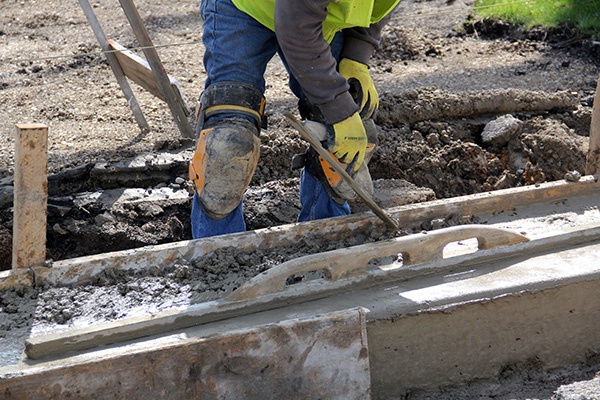1. Introduction
Purpose of Slab Footings
Slab footings play a vital role in providing a solid and stable foundation for buildings. They are horizontal slabs of steel-reinforced concrete, typically ranging from 100 to 500 millimeters in thickness. These footings are primarily used to construct floors and ceilings, while thinner slabs are also employed for exterior paving. The purpose of a slab footing is to evenly distribute the weight of the building and any loads it may bear, such as furniture or machinery, to the underlying soil or rock.
Benefits of Slab Footings
There are several advantages to using slab footings in construction projects:
- Cost-Effective: Slab footings are generally more economical compared to other foundation types, such as basements or crawl spaces, as they require less material and labor.
- Time-Efficient: The construction of slab footings is relatively quick and straightforward, enabling faster project completion timelines.
- Space Optimization: Slab footings eliminate the need for additional space below ground level, maximizing usable floor area in the building.
- Resistance to Moisture: Slab footings are less prone to moisture-related issues, such as water seepage or flooding, as they are built above the ground.
2. Preparing the Site
Before starting the construction of a slab footing, thorough site preparation is essential. This ensures a stable and level surface, which is crucial for the longevity and structural integrity of the footing.
Site Inspection and Layout
Begin by conducting a detailed site inspection to identify any potential issues or challenges. This includes assessing the soil composition, checking for underground utilities, and verifying the site’s boundaries. Once the inspection is complete, mark the layout of the slab footing on the ground using stakes and string lines. This will serve as a guide during the excavation process.
Excavation
Excavation involves removing the topsoil and any unsuitable materials from the site to reach the desired depth for the slab footing. Use excavation equipment, such as excavators or backhoes, to dig the trench according to the specified dimensions. Take caution to avoid damaging any existing utilities or nearby structures during the excavation process.
Compacting the Soil
After the excavation is complete, it is crucial to ensure that the soil underneath the footing is properly compacted. This helps to prevent settlement and provides a stable base for the concrete. Use a compactor or a hand tamper to compact the soil thoroughly. Pay close attention to any loose or soft spots and address them accordingly.
3. Reinforcing the Footing
Reinforcing the slab footing with steel reinforcement bars (rebar) is essential to enhance its strength and durability. The rebar helps to distribute the load evenly across the footing and reduce the chances of cracking or failure.
Selecting the Reinforcement Material
Choose the appropriate rebar size and type based on the structural requirements and local building codes. The rebar should be corrosion-resistant, such as epoxy-coated or stainless steel, to ensure long-term durability.
Placing the Rebar
Lay the rebar in the excavation trench according to the specified spacing and configuration. Use wire ties or rebar chairs to maintain the desired position and alignment of the reinforcement. It is crucial to ensure that the rebar is placed at the correct depth to provide adequate support for the concrete slab.
Tying the Rebar Together
Securely tie the intersecting rebar pieces together using wire ties or rebar clips. This helps to maintain the integrity of the reinforcement and prevents any movement during the concrete pouring process. Ensure that the rebar is securely fastened to the stakes and properly aligned.
4. Forming the Footing
Formwork is used to create the shape and dimensions of the slab footing before the concrete is poured. The formwork consists of panels or boards that are assembled to contain the concrete and provide support during the pouring and curing process.
Choosing the Formwork Material
Select the appropriate formwork material based on the project requirements and budget. Common options include timber, plywood, metal, or plastic formwork. Consider factors such as ease of assembly, reusability, and compatibility with the concrete mix.
Constructing the Formwork
Start by laying out the formwork panels or boards along the perimeter of the excavation trench. Ensure that the formwork is level and aligned with the string lines. Secure the formwork using stakes or braces to prevent any movement during the concrete pouring process.
Installing Formwork Braces
To provide additional support and stability to the formwork, install braces at regular intervals along the perimeter. These braces should be securely anchored to the ground and the formwork to prevent any bulging or shifting during the concrete placement.
5. Pouring the Concrete
Once the formwork is in place and properly secured, it is time to pour the concrete into the excavation trench. Proper concrete mixing and pouring techniques are essential to achieve a strong and durable slab footing.
Preparing the Concrete Mix
Follow the recommended concrete mix design, which typically includes cement, aggregates, and water. The concrete mix should have the appropriate consistency for easy pouring and proper compaction. Consider adding admixtures, such as plasticizers or air entrainment agents, to improve workability and durability.
Pouring the Concrete into the Formwork
Use a concrete pump or a wheelbarrow to transfer the concrete into the formwork. Start pouring the concrete from one end of the trench, ensuring that it fills the entire space evenly. Use a shovel or a rake to distribute the concrete and eliminate any air pockets or voids. Continue pouring until the formwork is completely filled.
6. Finishing the Footing
Proper finishing techniques are crucial to achieve a smooth and aesthetically pleasing surface for the slab footing. This involves using various tools and techniques to achieve the desired texture and appearance.
Using a Bull Float
Once the concrete is poured, use a bull float to level and smooth the surface. The bull float helps to remove any excess water and air bubbles, ensuring a dense and uniform concrete slab. Move the bull float in a back and forth motion, overlapping each pass, until the entire surface is smooth.
Edging and Jointing the Footing
After using the bull float, use edging tools to create rounded edges along the perimeter of the slab footing. This not only enhances the appearance of the footing but also helps to prevent chipping or cracking. Additionally, create control joints using a jointing tool to control the cracking pattern and minimize the chances of random cracks.
Curing the Concrete
Proper curing is essential to achieve maximum strength and durability of the concrete. After finishing the surface, cover the slab footing with a curing compound or plastic sheeting to retain moisture and prevent rapid drying. Maintain a moist environment for at least seven days to ensure optimal curing.
7. Common Mistakes to Avoid
While building a slab footing, it is important to be aware of common mistakes that can compromise the quality and stability of the structure. By avoiding these mistakes, you can ensure a successful construction project.
Insufficient Site Preparation
Neglecting proper site preparation, such as inadequate soil compaction or insufficient excavation, can lead to settlement and unevenness in the slab footing. This can result in cracking or structural problems in the building.
Inadequate Reinforcement
Failure to properly reinforce the slab footing with rebar or using the wrong size or type of reinforcement can weaken the structure and reduce its load-bearing capacity. This can result in cracking or even collapse under heavy loads.
Improper Concrete Placement
Improper concrete pouring techniques, such as uneven distribution or insufficient compaction, can result in weak spots or voids within the slab footing. This can lead to structural issues and decrease the overall durability of the building.
8. Tips for Success
To ensure a successful slab footing construction project, consider these tips:
Follow Local Building Codes and Regulations
Always adhere to local building codes and regulations when designing and constructing slab footings. These codes provide guidelines for factors such as minimum thickness, reinforcement requirements, and concrete mix design.
Seek Professional Advice if Needed
If you have limited experience or are unsure about any aspect of slab footing construction, it is advisable to seek professional advice. Consulting with a structural engineer or experienced contractor can provide valuable insights and ensure that the project meets the necessary standards.
Regularly Inspect and Maintain the Footing
Once the slab footing is complete, regularly inspect and maintain it to identify any signs of damage or deterioration. This includes checking for cracks, water seepage, or uneven settling. Promptly address any issues to prevent further damage to the structure.
9. Conclusion
Building a slab footing requires careful planning, proper execution, and adherence to industry standards. By following the step-by-step guide outlined in this article, you can construct a sturdy and durable foundation for your construction projects. Remember to prioritize site preparation, reinforcement placement, and concrete pouring techniques to ensure the long-term success of your slab footings. With the right knowledge and attention to detail, you can confidently tackle slab footing construction projects with ease.


No comments yet